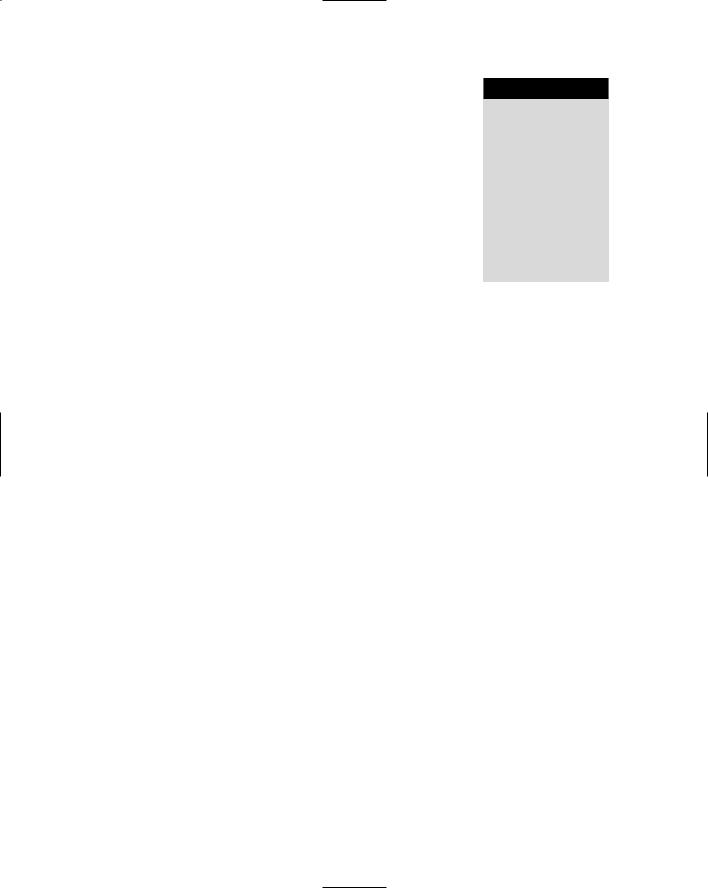
The Essential Guide to UI Design
.pdf


692Part 2: The User Interface Design Process
one more of a Christmas tree than of an effective source of communication. The evolution to graphical screens expanded the use of color, but did not immediately eliminate some of the color problems. Today, because technology has improved, as well as our understanding of what constitutes good design, colors in screens are being used much more effectively. Pastels have replaced bright reds and dark blues, and the number of colors presented at one time on a screen has been reduced, dramatically in some cases. This is not to say, however, that all the problems have been solved. A tour around the office will usually uncover some questionable, or awful, uses of color. Two of the most common problems are screen backgrounds being more attention-grabbing than the screen data (which is the most important element of a screen), and overuse of color as a graphic language or code (the color itself meaning something to the screen viewer). This latter kind of use forces the user to interpret a color’s meaning before the message it is communicating can be reacted to.
In recent years, the development of the Web and the availability of monitors with significantly-expanded color capability have initiated a replay of the early color-use problems that surfaced in both text-based and graphical systems. Infatuated with the almost unlimited supply of available colors, developers have eagerly raced to include a multitude of colors on Web pages, with too-little thought given to the consequences for users. The Christmas tree effect has lived on as users struggled with illegible text and numerous visual distractions. Today, the use of color in Web pages has improved somewhat. Too many site designers still, however, associate good design with splashy color.
The discussion to follow begins by defining color. Next is a review of how color may be used in screen design and some critical cautions on its use. Then, the human visual system and its implications for color are discussed. Continuing, a series of general screen guidelines are presented for choosing and using colors. This is followed by a compilation of guidelines for specific kinds of screens: textual and graphical, statistical graphics, and Web screens and their associated graphical elements.
Color — What Is It?
Wavelengths of light themselves are not colored. What is perceived as actual color results from the stimulation of the proper receptor in the eye by a received light wave. The name that a color is given is a learned phenomenon, based on previous experiences and associations of specific visual sensations with color names. Therefore, a color can only be described in terms of a person’s report of his or her perceptions. The visual spectrum of wavelengths to which the eye is sensitive ranges from about 400 to 700 millimicrons. Objects in the visual environment often emit or reflect light waves in a limited area of this visual spectrum, absorbing light waves in other areas of the spectrum. The dominant wavelength being seen is the one that we come to associate with a specific color name. The visible color spectrum and the names commonly associated with the various light wavelengths are shown in Table 12.1.

Step 12: Choose the Proper Colors 693
Light
VALUE
Dark |
Red |
|
|
Violet |
Orange |
|
|
|
|
||
Blue |
|
Yellow |
|
|
Green |
|
|
HUE |
HUE |
|
|
|
Low |
CHROMA |
High |
Figure 12.1: The relationship of hue, chroma, and value.
Table 12.1: The Visible Spectrum
APPROXIMATE COLOR WAVELENGTHS IN MILLIMICRONS
Red |
700 |
Orange |
600 |
|
|
Yellow |
570 |
Yellow-green |
535 |
|
|
Green |
500 |
|
|
Blue-green |
493 |
Blue |
470 |
|
|
Violet |
400 |
|
|

694 Part 2: The User Interface Design Process
To describe a color, it is useful to refer to the three properties it possesses: hue, chroma or saturation, and value or intensity, as illustrated in Figure 12.1. Hue is the spectral wavelength composition of a color. It is to this we attach a meaning such as green or red. Chroma or saturation is the purity of a color in a scale from gray to the most vivid version of the color. The more saturated a hue is, the more visible it is at a distance. The less saturated, the less visible it is. Value or intensity is the relative lightness or darkness of a color in a range from black to white. Two-word descriptors, such as light red or dark blue, are usually used to describe lightness differences. Some hues are inherently lighter or darker than others, for example, yellow is very light and violet is very dark.
The primary colors of illuminated light are red, green, and blue, whose wavelengths additively combine in pairs to produce magenta, cyan, and yellow, and all the other visible colors in the spectrum. The three primary colors additively combine to produce white. The long-wavelength colors (red) are commonly referred to as warm, and shortwavelength colors (blue) as cool.
Color, then, is a combination of hue, chroma, and value. In any one instance what we call “blue” may actually be one of several hundred thousand “blues.” This problem has confounded color research over the years. A blue may be unacceptable in one situation because it is highly saturated and dark, but perfectly acceptable in another, being less saturated and light. The exact measures of a color are rarely reported in the literature.
Colors appearing on a computer screen are only a small portion of the colors visible to the human eye. Therefore, accurate color reproduction of the real world is impossible. Differences may also exist between different monitors. These differences can cause problems for some applications. There are also differences between color presentation on a screen and on a paper. Paper versions can appear more vibrant and real.
RGB
Many color monitors use the three primary colors of light, in various combinations, to create the many colors we see on screens. By adjusting the amounts of red, green, and blue light presented in a pixel, millions of colors can be generated. Hence, color palette editors exist with labels R, G, and B (or the words spelled out).
HSV
Some palette editors use a convention based on the Munsell method of color notation called HSV, for hue, saturation, and value (or HSL for hue, saturation, and lightness). Again, various combinations produce different colors.
Dithering
The eye is never steady, instead trembling slightly as we see. If pixels of different colors are placed next to each other, this tremor combines the two colors into a third color. This is referred to as dithering, and sometimes texture mapping. Taking advantage of this phenomena, an optical illusion, a third color can be created on a screen. Dithering

Step 12: Choose the Proper Colors 695
is often used to create a gray scale when only black and white pixels are available to work with. A difference of opinion exists on whether dithering should, or should not, be used on a screen.
In systems containing large palettes of colors, the color-mixing process a computer goes through when it encounters a color not in its palette is also called dithering. In this process, palette colors are mixed to approximate the appearance of the desired color.
Color Uses
■Use color to assist in formatting a screen
—Relating or tying elements into groupings.
—Breaking apart separate groupings of information.
—Associating information that is widely separated on the screen.
—Highlighting or calling attention to important information by setting it off from the other information.
■Use color as a visual code to identify
—Screen components.
—The logical structure of ideas, processes, or sequences.
—Sources of information.
—Status of information.
■Use color to
—Realistically portray natural objects.
–– Increase screen appeal.
Color may be used as a formatting aid in structuring a screen, or it may be used as a visual code to categorize and identify information or data. It may also be used to portray objects naturally and make a screen more appealing to look at.
Color as a Formatting Aid
As a formatting aid, color can provide better structure and meaning to a screen. It can help users understand what does and does not go together. Research has found that people find it difficult to ignore the grouping principle of color similarity. It has a stronger perceptual influence than proximity or grouping (Beck and Palmer, 2002).
Color is especially useful when large amounts of information must be included on a screen and spacing to differentiate components is problematic. For example, displaying groupings of information in different colors can enhance differentiation of the groupings. Spatially separated but related fields can also be tied together through a color scheme.
Color can also replace highlighting as a means of calling attention to information. Color is much more flexible than other techniques because of the number of colors that are available. Color, as an attention-getting mechanism must, however, be chosen in light of the psychological and physiological considerations to be described shortly.

696 Part 2: The User Interface Design Process
Color as a Visual Code
A color code indicates what category the information being displayed falls into. It has meaning to the screen’s user. A properly selected color-coding scheme permits a person to identify a relevant information category quickly, without having to read its contents first. This permits focusing on this category, while the remaining information is excluded from attention.
One past common color-coding scheme used to differentiate screen components was to display screen captions and data in different colors. Another is to identify information from different sources — information added to a process from different locations, or text added to a message from different departments, may be colored differently. Using color-coding to convey status might involve displaying, in a different color, information that passed or failed system edits. Color can also be used as a prompt, guiding a person through a complex transaction.
To be effective, color as a visual code must be relevant and known. Relevance is achieved when the color enables a person to attend to only the information that is needed, and easily exclude that which is not needed. A relevant code, however, will be useless unless it’s meaning is also understood by the person who must use it. If a color’s meaning is not known, one must first interpret its meaning. This can place burdens on a person’s memory. It can also impede performance, requiring one to consult a manual or a legend in order to understand it.
Other Color Uses
Color can also be used to more realistically portray objects in the world around us that must be displayed on a screen. It is also thought that the addition of color increases a screen’s appeal and makes working with a display more pleasant.
Possible Problems with Color
The simple addition of color to a screen will not guarantee improved performance. What may have been a poorly designed product will simply become a colorful poorly designed product. When used improperly, color may even impair performance by distracting the viewer and interfering with the handling of information. Possible problems may be caused by the perceptual system itself, the physiological characteristics of the human eye, and user expectancies.
High Attention-Getting Capacity
Color has an extremely high attention-getting capacity. This quality causes the screen viewer to associate, or tie together, screen elements of the same color, whether or not such an association should be made. A person might search for relationships and differences that do not exist, or that are not valid. The result is often bewilderment, confusion, and slower reading. The effect achieved is often described as the Christmas tree mentioned earlier.

Step 12: Choose the Proper Colors 697
Interference with Use of Other Screens
Indiscriminate or poor use of color on some screens will diminish the effectiveness of color on other screens. The rationale for color will be difficult to understand and its attention-getting capacity severely restricted.
Varying Sensitivity of the Eye to Different Colors
All colors are not equal in the eye of the viewer. The eye is more sensitive to those in the middle of the visual spectrum (yellow and green), which appear brighter than those at the extremes (blue and red). Thus, text composed of colors at the extremes is thought to be more difficult to read. Research evidence on this topic is mixed. Several studies have found that acuity, contrast sensitivity, target recognition, legibility, and performance were not influenced by color. On the other hand, other studies have found advantages for central spectral colors in reaction times, resolution, and error rates.
Also, it is thought that some combinations of screen colors can strain the eye’s accommodation mechanism. The wavelengths of light that produce blue are normally focused in front of the eye’s retina, the red wavelengths behind it. Simultaneous or sequential viewing of red and blue causes the eye to continually refocus to bring the image directly onto the retina, thereby increasing the potential for eye fatigue. Again, the research evidence is mixed. Some studies have found this a problem while others have not.
What does one conclude after looking at the research addressing the aforementioned problems? The reasonable assumption is that they have neither been proved nor disproved. We have not properly defined all the screen-based tasks being performed, and the exact qualities of the colors being studied. Also, the studies have used only a few of the many devices in existence. And, a firm definition of “visual fatigue” remains elusive. Finally, none of the studies have addressed extended screen viewing. The prudent course is to be cautious and avoid using colors and combinations that color theory suggests can create problems.
The perceived appearance of a color is also affected by a variety of other factors, including the size of the area of color, the ambient illumination level, and other colors in the viewing area. Also, larger changes in wavelength are needed in some areas of the visual spectrum for a color change to be noticed by the eye. Small changes in extreme reds and purples are more difficult to detect than small changes in yellow and blue-green. Failure to consider the eye and how it handles color, then, can also lead to mistakes in color identification, misinterpretations, slower reading, and, perhaps, visual fatigue.
Color-Viewing Deficiencies
Another disadvantage of color is that about 8 percent of males and 0.4 percent of females have some form of color-perception deficiency—color blindness, as it is commonly called. In actuality, very few people are truly color-blind; most of those with problems simply have difficulties discriminating certain colors. A red viewing deficiency is called

698Part 2: The User Interface Design Process
protanopia, a green deficiency is called deuteranopia, and a blue deficiency is called tritanopia. These common color deficiencies, their results, and the percentage of people who experience these problems, are summarized in Table 12.2. Total color blindness affects no more than 0.005 percent of both sexes. For an individual with color-perception deficiency, all the normal colors may not be discernible, but often differences in lightness or intensity can be seen. The important point: A person experiencing any form of color deficiency must not be prohibited from effectively using a screen.
Color Connotations
Human reactions to colors are formed in many ways. They may be due to color associations learned in childhood or to how color has been consistently applied to objects and entities in the environment around us. As a result, colors have developed certain meanings to people in certain situations, either personally in a discipline, or in a culture. A color used in an unexpected way can cause confusion. An error signaled in green would contradict the expected association of red with stop or danger. The same color may also have a different connotation, in the eyes of its viewer. Some common color connotations are presented in Table 12.3. This Table is based upon Gotz (1998) and Stone et al. (2005).
Table 12.2: Results of Color-Defective Vision
|
|
COLOR SEEN WITH: |
|
|
RED-VIEWING |
GREEN-VIEWING |
BLUE-VIEWING |
ACTUAL COLOR |
DEFICIENCY (2.04%) |
DEFICIENCY (6.39%) |
DEFICIENCY (0.003%) |
Red |
Brown |
- |
- |
|
|
|
|
Yellow |
Greenish-Yellow |
Orange |
Deeper Yellow |
Purple |
Dark Blue |
Red |
Deep Red |
|
|
|
|
Green |
- |
Light Brown |
- |
|
|
|
|
Brown |
- |
Reddish-Brown |
- |
Blue |
- |
- |
Green |
|
|
|
|
From Barnett (1993); Fowler and Stanwick (1995).
Table 12.3: Common Color Connotations
COLOR |
POSITIVE |
NEGATIVE |
Red |
Active |
Aggressive |
|
Attractive |
Alarming |
|
Dominating |
Energetic |
|
Exciting |
|
|
Invigorating |
|
|
Powerful |
|
|
Strong |
|

